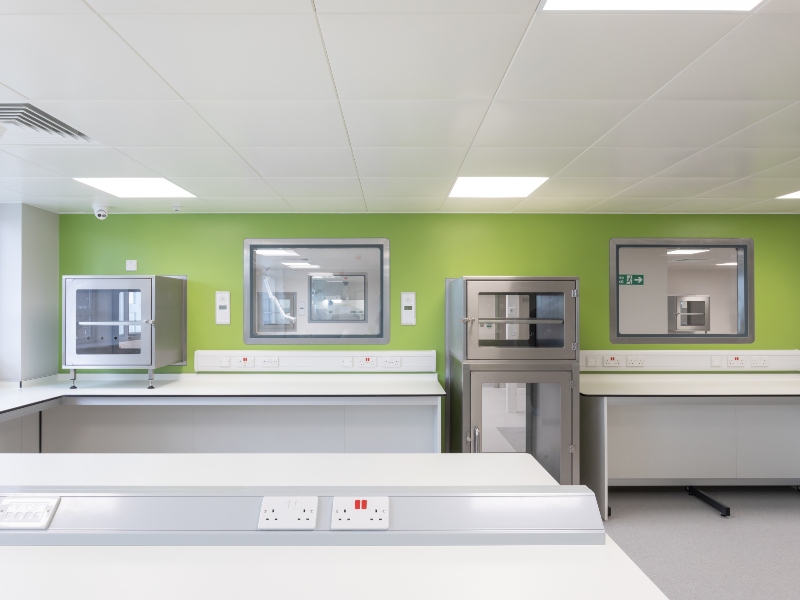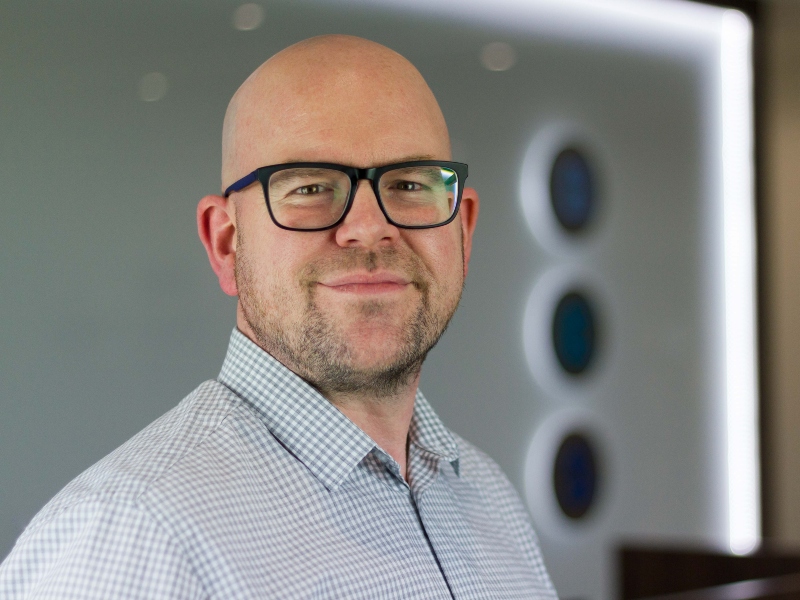The design and build sector faces ‘on budget/on time’ delivery challenges constantly, particularly so in the pharmaceutical and healthcare markets where such requirements come into even sharper focus. Cleanroom and laboratory environments created by design consultancy and contractor BES, have the added complexities of fully documented compliance; however, the company is committed to ensuring early engagement from in-house multidisciplinary teams helps to mitigate the risks and deliver a seamless project.
As COO of BES, I have gained considerable cleanroom experience working alongside the NHS, pharmaceutical and biotech companies and have experienced first hand the importance and benefits of early engagement.
The UK healthcare construction market faced increased demand in 2021 for healthcare provision during the pandemic, which positively stimulated what was a declining market over recent years. COVID-19 has placed unprecedented demand on healthcare services and accelerated change, with the future resilience of services a concern for all.
Growth in lab and manufacturing is soaring as the sector deals with ‘business as usual’
Alongside, the pharma industry is booming with a rapid acceleration of construction projects and significant investments. Growth in lab and manufacturing is soaring as the sector deals with ‘business as usual’ as well as new product development, with pressures on bringing essential products to market fast.
BES has seen evidence of this trend alongside increased demand in the sophistication of cleanroom and laboratory design.
Improved and more efficient facilities are required faster and within ever more tightly controlled budgets. Increased infection control and operator safety measures mean architectural design, specifications and validation become ever more involved coupled with the different demands of new technologies and highly sophisticated environments. Whether a new build or refurbishment - keeping adjacent highly critical BAU facilities operational during construction, compounds the delivery challenges.
BES designs and constructs in line with Health Technical Memorandums (HTMs) and Health Building Notes (HBNs), while the pharmaceutical compliance meets Good Manufacturing Process (GMP) Medicines and Healthcare Products Regulatory Agency (MHRA) and Food and Drug Administration (FDA) guidelines.

West Park hospital
These critical documents and guidelines set out regulatory industry compliance, however under increasing focus due to energy price rises and sustainability is the emphasis on a building’s lifecycle costs and carbon footprint also; not least due to the heavy reliance within clean rooms on HVAC systems and the need for a high level of resilience and spare capacity. Understanding the implications of the physical size and coordination along with the complexities of installation of all these utilities is a key aspect of early engagement, as these have a high influence on fundamental decisions about project location and future maintainability.
A traditional procurement route for a typical project may involve clients recruiting input from various independent parties, including architects, engineers, services designers, specialist contractors and cost consultants. Surrounding yourself with experts may seem like an obvious approach to help with such a complex project ahead. However, if costs start to run over or timescales slip, this approach can be further compounded by growing angst between the different and independent parties, whose focus may be viewed from their own interests or perspective.
At BES we work differently to mitigate these risks from the very outset.
In-house multi-disciplinary expertise
Capitalising on 20 years experience, we have developed fully integrated multi-disciplinary teams in-house to provide a full ‘end-to-end’ turnkey service across design and construction. We have invested in a large team of 50 designers who work closely with all other disciplines from the start to mitigate the two most significant risk factors of any project – cost and programme.
At the initiation of any new scheme, we actively engage with all the in-house disciplines needed to be a part of a successful design and build project, including architects, process, mechanical and electrical specialists, alongside the validation team and full construction services. Most importantly, though engagement with end users provides valuable insight into operations and facility usage and an honest and open discussion with the client about risk management, construction, commercial approach, risks and timeframe ensures full transparency and alignment from the outset.
Our focus is clear, meeting the agreed project objectives and specification and our aim is to do all within our powers to reduce any risks to zero at the start. Compared with traditional build approaches where many independent parties are brought together, we can achieve this in a non-competitive manner with in-house teams working together with the same end goal in mind.
A tailored digital document management system ensures regulatory compliance is more efficiently controlled throughout the project
At each stage of every project are a series of reviews, as part of our best practice approach. Early on a user consultation process allows us to fully interrogate the design parameters of a project; there are optioneering opportunities at key stages in the design process and we embed learning in design development and question decisions as the phases progress. Having the construction team on hand throughout enhances buildability and simplifies ideas from the outset.
We can have an open discussion on the best methods of construction, this may include modular compared with traditional approaches or a combination of the two. Modular solutions are providing alternative options to capitalise on speeding up the build process while maintaining quality and flexibility.
Collaborative culture
Pulling together the right skill set for a project is one thing, ensuring that everyone can operate within a supportive culture is another, yet this is an integral part of the working ethos at BES. We focus on collaboration, and consequently, we developed a bespoke leadership training programme, not just for the senior team but for everyone. This is the ‘living leader’ programme with emphasis on emotional intelligence, which has helped enhance communication and effective management, enabling our teams to work increasingly more cohesively. Not a common approach in our sector, yet one that is serving us well and believes helps set us apart.
Technologies & validation
We combine our multi-disciplinary and collaborative approach alongside embracing new technologies, from advanced 3D design capabilities so our clients’ projects become virtual reality at the earliest opportunity allowing us to actively encourage the involvement of end-users.
A tailored digital document management system ensures regulatory compliance is more efficiently controlled throughout the project, and managing validation documentation from the start becomes part of the natural process, again helping keep the project on track and to schedule.
The use of smart design strategies and digital modelling tools are helping to provide more accurate evidence of energy efficiency opportunities, these are invaluable assets to demonstrate how both carbon and OpEx savings can be achieved. This data helps with identifying the opportunities for maximising on economies, which can be debated with the whole team and built into the overall scheme. It goes without saying addressing this at the outset has huge potential savings later.
Project first approach

Having been fortunate to be working at the cutting edge with several leading global pharmaceutical clients who are innovators in their field, we can apply this knowledge and experience to new projects, which enables us to influence key decisions and user requirements early on. We can also cross fertilise information between sectors, bringing some of the advancements in pharmaceuticals to healthcare environments and vice versa.
For example, when working within aseptic areas we are able to draw on previous experience to evaluate the advantages and disadvantages of RABS (Restricted Access Barriers) versus Isolators. We are able to challenge air change norms, which are often historic and embedded within out-of-date specifications. We can easily provide comparative cost information on a whole host of facility finishes, including wall types, doors, floors etc and can provide firsthand experience of risks and how to mitigate these.
We can cross fertilise information between sectors
Each project we tackle presents its own challenges. However, we’ve built our expertise since 2002, and we learn from each facility that we’ve completed, bringing this experience to each new project. We are not replicating designs but applying knowledge alongside the clients’ requirements. This is invaluable and enables us to influence constructability and provide sound advice and respond quickly to changes and will be able to advise what impact certain changes will have on realistic build timescales. We can consider design or process options at speed allowing the client to rule them in or out without delay.
Our desire is to design and deliver exemplary buildings through providing a high level of service, being best in class and delivering what we say we will. It’s a holistic approach from all aspects of the services coming together to consider options and make informed decisions. Ultimately, to have the full skill set required for one project in-house will mean a smoother operation that delivers more quickly coupled with a unified desire to progress the design and build to schedule and on budget. With continuity and business resilience priorities, the onus is on us to have responsibility to build a quality facility to schedule at the end, it makes sense everyone is involved from the start.

